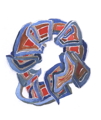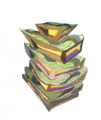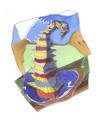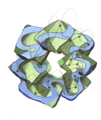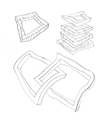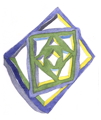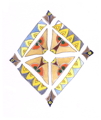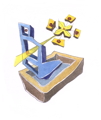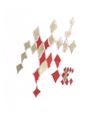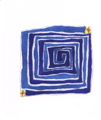
| What is a divination drawing? | Home | Free email subscription |
November 2011
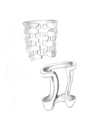
|
Meditation phylogon.
It breathes in with many holes. It breathes out with only a few. |
| 11.2.2011 | |
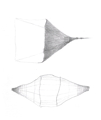
|
Phylogon Engine Operating Manual: Appendix A : Phylogon History
Phylogon comes from The Divine Invasion , a novel by Philip K. Dick [hereafter referred to as PKD]. In The Divine Invasion, PKD coins the term 'phylogon' but only uses the word three times in the story. In this excerpt, the main character, Emmanuel, a human embodiment of the god Yah, begins to experiment with certain abilities he has discovered inside himself. "First he speeded up his internal biological clock so that his thoughts raced faster and faster; he felt himself rushing down the tunnel of linear time until his rate of movement along that axis was enormous. First, therefore, he saw vague floating colors...beyond this point he began to travel at the rate of the Upper Realm, so that the Lower Realm ceased to be something but became, instead, a process..." The timeless state, described above as the Upper Realm, can be created in the Phylogon Engine by issuing the command: SET_TIME_MODE(0). When one 'pops out' of their current phylogon into this Upper Realm, they no longer experience the passage of time. The shift in point of view when transitioning between Upper and Lower Realm is a shift from seeing things to seeing the process that creates and destroys things; seeing their complete history. It is a mindful move from experiencing and sensing the world to detachment and observation. |
| 11.7.2011 | |
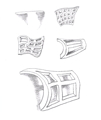
|
The programmer shifts in his seat, loving how much there is to learn about phylogons. There is nothing else for him right now beyond this knowledge.
Appendix A continues: PKD did not refer to the phylogons in print beyond the paragraphs in The Divine Invasion. However, he does discuss the concept in some of his published letters. The parts of the letters relevant to phylogons are summarized by John Fairchild and reprinted by Ragle Gumm in this blog post. PKD's letters reveal his struggle for a rational explanation of his visions. The struggle led him to theorize that the visions were projections of a fourth spatial dimension into our more familiar three. When a sphere passes through the plane in E. A. Abbott's Flatland, the residents of the plane see a tiny circle appear, grow, shrink and disappear again. Who is to say that the warping of higher dimensional forms doesn't cast some shadows onto what we see everyday? Fairchild states, "One of the things [PKD] saw he labeled phylogons. This is Phil's term for the Forms of the macrometasomakosmos that get morphologically arranged conceptually. The phylogons are permanent and accrete new layers. The phenomenal flux world, the world we normally see, is being converted into a conceptually arranged structure, being accreted into the macrometasomakosmos, laminating down in successive waves. PhilÕs term for what gets accreted is ontogons. These are non-permanent. And here he directly quotes PKD's letters: "The billions of phylogons are crosslinked to form a unitary reality which is Pythagoras' kosmos, 'the harmonious fitting-together of the beautiful,' a vast structure that is sentient, that assimilates its environment selectively, using the ... universe as a supply of parts." (p.13)"The first thing of note is the introduction of the term 'ontogons'; the accreting layers. Coincidentally, Ontogons are being included as a new feature in the upcoming release of the Phylogon Engine Operating System v2.0, due out fourth quarter 2011. The second idea of note is PKD's assertion that phylogons are conceptually arranged; that the underlying structure of reality comes from intelligence. To quote his letters... "I believe that they are conceptually arranged; that is, in terms of meaning. They have the same necessary relationship to one another that logical truths or mathematical propositions have to one another." (p.116) |
| 11.12.2011 | |

|
Descending_Phylogons, alternate_grid(TRUE); |
| 11.14.2011 | |
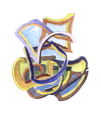
|
The programmer begins to see just how complicated some decisions can be. |
| 11.18.2011 | |
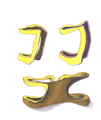
|
Technique for joining two phylogons.
Backside merger. Looking all around but ending up in the same place. |
| 11.21.2011 | |
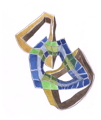
|
Technique for joining two phylogons.
Overlay a gridded phylogon on two unconditioned phylogons. The grid will map the areas underneath. The imposed grids are used for alignment. |
| 11.22.2011 | |
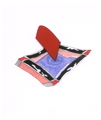
|
Technique for generating phylogons.
When the timeless intersects material space, the ripples create new phylogons. |
| 11.23.2011 | |

|
Technique for generating phylogons.
Drawing closer to the timeless, new phylogons appear. |
| 11.24.2011 | |

|
Criteria for arranging phylogons.
Color, size, shape, sequence, like, dislike, resonance, transparency, convention, invention, persistence, complexity, and truth. |
| 11.25.2011 | |




